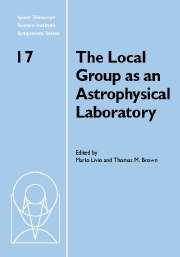 The Local Group as an Astrophysical Laboratory
The Local Group as an Astrophysical Laboratory Published online by Cambridge University Press: 12 May 2010
The primordial abundances of deuterium, helium-3, helium-4, and lithium-7 probe the baryon density of the Universe only a few minutes after the Big Bang. Of these relics from the early Universe, deuterium is the baryometer of choice. After reviewing the current observational status of the relic abundances (a moving target!), the baryon density determined by big bang nucleosynthesis (BBN) is derived. The temperature fluctuation spectrum of the cosmic background radiation (CBR), established several hundred thousand years later, probes the baryon density at a completely different epoch in the evolution of the Universe. The excellent agreement between the BBN- and CBR-determined baryon densities provides impressive confirmation of the standard model of cosmology, permitting the study of extensions of the standard model. In combination with the BBN- and/or CBR-determined baryon density, the relic abundance of 4He provides an excellent chronometer, constraining those extensions of the standard model which lead to a nonstandard early-Universe expansion rate.
Introduction
As the hot, dense, early Universe rushed to expand and cool, it briefly passed through the epoch of big bang nucleosynthesis (BBN), leaving behind as relics the first complex nuclei: deuterium, helium-3, helium-4, and lithium-7. The abundances of these relic nuclides were determined by the competition between the relative densities of nucleons (baryons) and photons and, by the universal expansion rate. In particular, while deuterium is an excellent baryometer, He provides an accurate chronometer.
To save this book to your Kindle, first ensure [email protected] is added to your Approved Personal Document E-mail List under your Personal Document Settings on the Manage Your Content and Devices page of your Amazon account. Then enter the ‘name’ part of your Kindle email address below. Find out more about saving to your Kindle.
Note you can select to save to either the @free.kindle.com or @kindle.com variations. ‘@free.kindle.com’ emails are free but can only be saved to your device when it is connected to wi-fi. ‘@kindle.com’ emails can be delivered even when you are not connected to wi-fi, but note that service fees apply.
Find out more about the Kindle Personal Document Service.
To save content items to your account, please confirm that you agree to abide by our usage policies. If this is the first time you use this feature, you will be asked to authorise Cambridge Core to connect with your account. Find out more about saving content to Dropbox.
To save content items to your account, please confirm that you agree to abide by our usage policies. If this is the first time you use this feature, you will be asked to authorise Cambridge Core to connect with your account. Find out more about saving content to Google Drive.